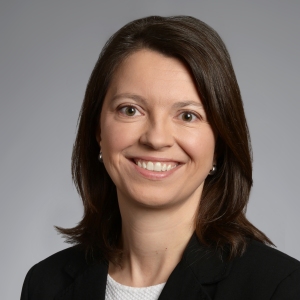Interview With Dr. Maria Dietrich of the University of Missouri

Maria Dietrich is an Assistant Professor of Speech, Language and Hearing Sciences at the University of Missouri and director of the Vocal Control and Vocal Well-Being Lab. Her research focuses on how individuals differ in their vocal control and vocal behavior as a function of stressor exposure and personality and the resulting implications for risk for voice disorders such as muscle tension dysphonia.
Note: You should consult with your doctor or speech pathologist for recommendations on treatment. The views and opinions expressed in this article are those of Dr. Dietrich and do not necessarily reflect the official policy or position of SpeechPathologyMastersPrograms.com
How did you become interested in researching voice?
I enjoyed singing in choirs as a child and teenager and when I studied speech-language pathology at the University zu Köln (Cologne) in Germany I added music therapy as a minor. As part of the minor degree, I received piano and voice lessons with piano being my first instrument and voice my second. Naturally I became interested in voice disorders and finally made voice science my career. A couple of years ago, I had private voice lessons again at the University of Missouri, which gave me important personal insights into this amazing instrument.
What are some of the most important things we have learned about detecting voice disorders and voice disorder treatment in the past couple of decades?
The detection of voice disorders, in particular vocal fold pathologies, has been greatly aided by advances in laryngeal imaging technology such as high-definition laryngeal videostroboscopy. Ongoing advances in laryngeal high-speed imaging combined with automated measurements of vocal fold function will further improve diagnostic precision. Various devices for ambulatory monitoring of voice have been developed that help to better understand vocal load and risk factors in occupational voice users. These devices have become smartphone-based applications and neck sensors can now also track aerodynamic function besides pitch and loudness and can be combined with biofeedback based on motor learning principles. My own research shows promising results that a pattern recognition algorithm can differentiate with greater than 90% accuracy between individuals with and without self-reported vocal fatigue based on surface electromyography (sEMG) data from the extralaryngeal muscles. Thus, wearable technology to assess vocal function has become an important aspect in clinical voice science not least because of its potential to detect preclinical problems. With regard to voice therapy, semi-occluded vocal tract exercises such as Vocal Function Exercises or straw phonation have become a central part in most voice therapy and we have gained a critical body of research supporting these approaches. Furthermore, we have gained important knowledge on therapy delivery including assessing readiness for voice therapy, motivational interviewing, and structuring exercises according to motor learning principles.
What are some of the most important questions about voice disorders that we still need to answer?
Biological and genetic aspects of voice disorders are fascinating. We need to learn more about individual differences in vocal fold biology and resilience to voice disorders, the role of the laryngeal microbiome in voice disorders, and hereditary risks for vocal fold lesions and other voice disorders so that we can further improve prevention, treatment, and long-term treatment efficacy. For some voice disorders, like primary muscle tension dysphonia, we yet have to uncover the underlying pathophysiology and studying the central control of voice in the brain is ultimately one step toward that goal.
What are the main risk factors for developing a voice disorder?
Vocal fatigue with or without phonotraumatic changes in the vocal folds is common in individuals with voice disorders. Main risk factors are essentially a combination of factors that in their interaction promote voice disorders. A high vocal load with unfavorable voice use patterns such as increased loudness, hard glottal attacks, a tendency for breath holding or limited airflow support for voicing, and on top of that lack of adequate rest for the vocal folds can be quickly detrimental for vocal folds. Relaxing voice exercises such as lip trills or straw phonation scattered throughout the day help to counteract the negative effects.
How can personality and psychology affect voice and the risk of voice disorder?
We all have behavioral inclinations; some who like to to be the center of attention may become more excited or impulsive when socially rewarded or when stressed while others who are socially more inhibited tend to become more physically tense when stressed with negative effects on breathing. We believe that there are people who are laryngeal stress responders and that their behavioral tendencies translate to the larynx. However, a certain threshold or psychological burden likely has to be passed so that psychological factors lead to a voice disorder as opposed to just normal fluctuations in voice. Furthermore, cognitive-emotional factors such as excessive worry may hinder voice therapy success and long-term treatment efficacy and should be addressed in voice therapy.
How do you select new research projects?
I am definitely a programmatic researcher. As a doctoral student, I studied Roy and Bless’s (2000) Trait Theory of Voice Disorders, in particular the part describing links between personality traits and primary muscle tension dysphonia. The Trait Theory became the foundation for my dissertation work but I honed in on on one aspect of the theory and developed my own psychobiological framework for studying psychological stress and its relation to voice disorders (Dietrich & Verdolini Abbott, 2008). Since then I have been studying aspects of the Trait Theory and my framework using a variety of methods. Using sEMG to study extralaryngeal muscle function continues to be central in my research program. Networking opportunities have connected me with an engineer on campus who is now my collaborator on an NIH grant to classify sEMG signals using pattern recognition algorithms for the early detection of vocal fatigue in student teachers. Our next step will be to have participants wear sEMG sensor while they produce speech tasks in an MRI scanner.
What part of your research are you most proud of?
I am proud of my work using fMRI to better understand the limbic and cortical control of voice. Learning fMRI methods, which felt like learning a new language, was an investment in my future and the hard work paid off. I am proud of the knowledge and skills that I gained so that I could answer specific research questions and I am looking forward to learning more. In fact, my recent highlight was that my manuscript, “Limbic and Cortical Control of Phonation for Speech in Response to a Public Speech Preparation Stressor” was just accepted for publication in a brain imaging journal named Brain Imaging and Behavior.
Do you have advice for future speech pathology students?
Stay curious and ask questions. Learning comes from the interaction with class material, the professors, and the clinical instructors. I too always learn something from students’ questions and comments and from reading clinical and research literature across disciplines.
Sponsored online speech pathology programs

Online MS: Pursue SLP Certification. Study FT/PT
Speech@Emerson enables you to earn an MS online and pursue SLP certification in as few as 20 mos. Learn the same curriculum as the on-campus program. Study FT or PT.
- Prepares you to pursue certification as an SLP generalist
- In-person clinical placements at faculty-approved partner sites
- As few as 20 months to complete
SPONSORED

Want to Become an SLP? Earn an MS Online at NYU
NYU Steinhardt’s online master of science program in Communicative Sciences and Disorders prepares aspiring speech-language pathologists with a comprehensive professional education.
- Prepares students to pursue SLP licensure
- Accredited by ASHA’s Council on Academic Accreditation
- As few as six terms to complete
- Full-time and part-time plans of study
SPONSORED

Online MS in Speech-Language Pathology from Pepperdine University
Pepperdine University’s online Master of Science in Speech-Language Pathology program combines a robust, innovative curriculum rooted in Christian values with a full-time or part-time option that features online learning, on-campus intensive experiences, and comprehensive clinical field practicums to prepare skilled, compassionate students for careers as speech-language pathologists.
- Full-time (five trimesters) or part-time (eight trimesters) options available.
- No GRE scores required.
- 400+ supervised, clinical learning hours are done at schools/clinics local to students
- Three onsite experiences build a sense of camaraderie and community throughout the program
SPONSORED

